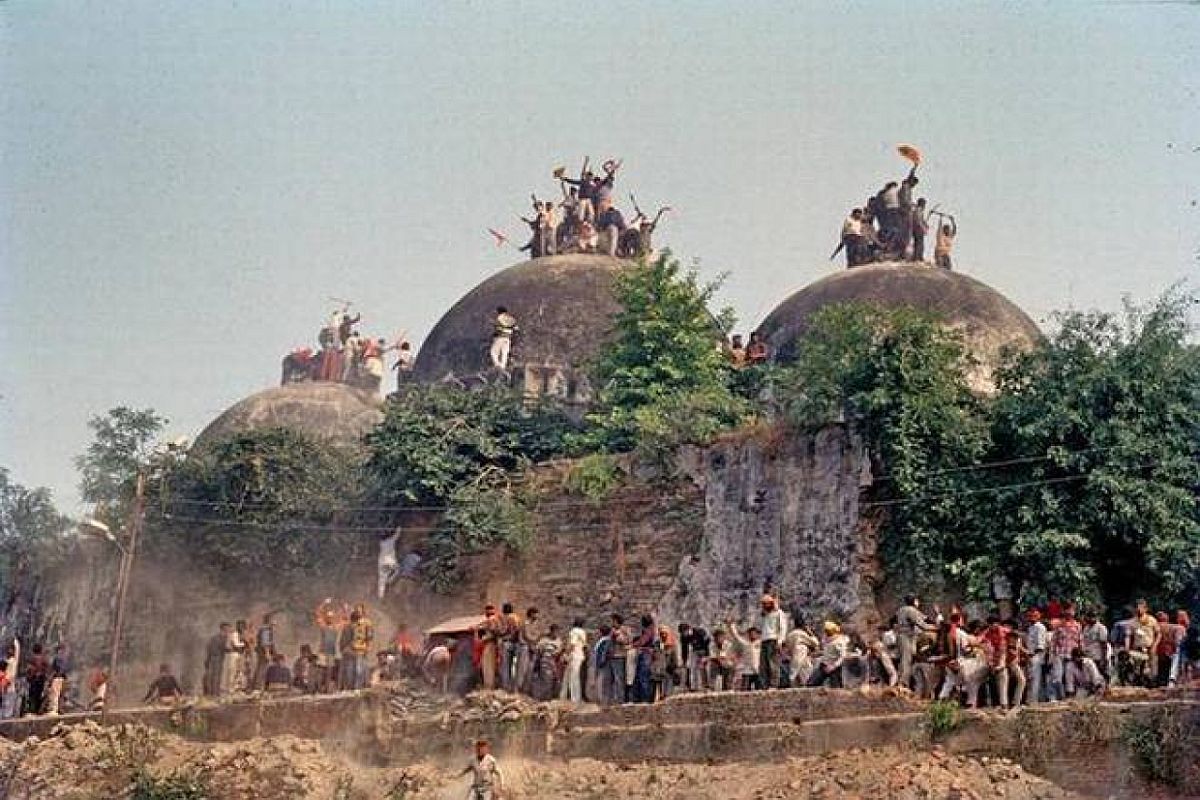Assam’s grand Jhumoir show: 8,000 performers, PM Modi to attend
Assam’s Jhumoir Binandini event on February 24 will feature over 8,000 performers showcasing the traditional Jhumoir dance at Sarusajai Stadium, Guwahati.
The letter, which was sent on February 15, said a graveyard exists around the demolished Babri Masjid and that Muslims, who lost their lives in the 1885 riots in Ayodhya, were buried there.

Kar sevaks in Ayodhya demolishing Babri Masjid (File Photo: Wikimedia Commons)
A group of Muslim residents in Ayodhya has sent a letter to the temple trust saying that construction of the Ram temple on the graves of Muslims will be a violation of ‘Sanatan Dharma’.
The letter has been sent by MR Shamshad, the advocate who represented the Muslim side in the Ayodhya title dispute case.
Advertisement
The letter, which was sent on February 15, said a graveyard exists around the demolished Babri Masjid and that Muslims, who lost their lives in the 1885 riots in Ayodhya, were buried there.
Advertisement
The letter further said: “As per recorded facts, 75 Muslims were killed in the riots of 1885 and they were buried in an existing graveyard around the mosque. Even thereafter, this land was used as a graveyard.”
“The Central government has not considered the issue of not using the graveyard of Muslims for constructing the grand temple of Lord Ram. It has violated ‘dharma’,” the letter stated.
The letter is addressed to senior Supreme Court lawyer K. Parasaran, who is heading the trust, as well as the other trustees, and asks them to consider whether it is acceptable to have a Ram temple over the graves of Muslims.
“Now you all trustees are persons of eminence in contemporary India and have the best knowledge and experience in the field of Hindu/Sanatan religion and practice. In view of religious scriptures of Sanatan Dharma, you need to consider whether the temple of Lord Ram Janamsthan can have foundation on the graves of Muslims? This is a decision that the management of the Trust has to take,” the letter said.
Talking to local reporters, Shamshad explained: “The fact is that about five acres of this 67-acre land is a graveyard. When the acquisition had taken place in 1993, after the demolition of the Babri mosque, the plan was to build a temple, mosque, library — everything within this 67 acre.”
He said that the government has completely ignored the claim of Muslims in 67-acre land.
The letter also refers to the Ismail Faruqui verdict of 1994, which had said that the ‘disputed structure was surrounded by a graveyard on three sides’.
Referring to the judgement, the letter said, “After the 1994 judgement of the SC in the Ismail Faruqui case, the dispute between mosque and Ram temple remained confined to 1,480 sq yards”.
The letter also referred to the Acquisition of Certain Area at Ayodhya Act (1993), saying that the exclusion of mosque from the land is “uncalled for”.
“With all humility and respect to Lord Ram, I request you not to use the land of about 4-5 acres in which the graves of Muslims are there, around the demolished mosque. The graves may not be visible today considering the fact that the entire area has been differently treated with since 1948 when forcibly an idol of Lord Ram was placed inside the mosque and when, in 1992, the mosque was demolished,” it added.
Shamshad, who represented Iqbal Ansari, one of the Muslim litigants in the title dispute case, said he wrote the letter on behalf of multiple Ayodhya residents.
On January 5, Prime Minister Narendra Modi announced in the Lok Sabha that the government has given approval to a proposal for “Shri Ramjanmabhoomi Tirtha Kshetra” trust to take care of the construction of grand Ram temple in Ayodhya and other related issues.
The trust has “autonomy” and will be able to take decisions on Ram temple and other related issues “freely”.
PM Modi announced that the 67.703-acre land earmarked for the construction of the Ram temple will also be handed over to the trust. He said that a plan has been prepared for the construction of the temple on Ram “janmasthali”.
In a landmark judgement, a five-judge bench headed by Chief Justice Ranjan Gogoi on November 9, 2019, ruled that the disputed 2.77-acre land will be taken over by a Government trust for the construction of the temple, while a suitable alternative plot of land measuring 5 acres at a prominent site in Ayodhya will be given to the Sunni Wakf Board.
The Supreme Court had also asked the Centre to set up the board of trustees within three months after which the disputed land will be handed over to the trust.
However, many Muslim leaders were upset with the government deciding to use the entire 67-acre for the temple, and allotting an alternative land elsewhere for the mosque.
Advertisement